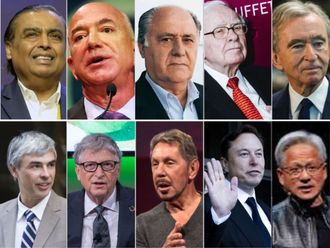NEW YORK: General Electric Co. topped Wall Street’s earnings expectations for the second straight quarter, offering investors a measure of relief after a wrenching share collapse.
Strong demand for aviation and health-care equipment boosted quarterly results for the beaten-down manufacturer, which is attempting to avoid further missteps while shoring up operations. While GE said industrial cash flow would end the year at the low end of the expected range, the company maintained a 2018 profit forecast of $1 to $1.07 a share, according to a statement Friday.
The steady performance bolsters GE’s efforts to find a bottom to one of the deepest slides in its 126-year history. After unveiling a long-awaited turnaround plan last month, Chief Executive Officer John Flannery is now aiming to put that plan in motion and restore confidence in what stands to be a smaller and more-focused industrial manufacturer.
“With our strategic review now complete, GE is moving forward to implement the strategy and structure we laid out in June,” he said in the statement. “Our focus is on unrelenting execution of this plan to improve operating results, strengthen our balance sheet, accelerate growth across our businesses and increase shareholder value.”
Earnings beat
GE advanced less than 1 per cent to $13.85 ahead of regular trading in New York. While the shares fell 21 per cent this year through Thursday, they managed to climb 1 per cent from April to June, marking the first quarterly gain since late 2016.
Adjusted profit fell to 19 cents a share in the second quarter, while analysts predicted 18 cents. Sales rose 3.5 per cent to $30.1 billion, compared with expectations of $29.4 billion.
GE anticipates industrial free cash flow this year of $6 billion, the low end of its earlier projection of as much as $7 billion. The company attributed the reduced expectations to challenges in the power unit.
The quarter was a volatile one, even by GE’s recent standards. The flagging giant was kicked out of the Dow Jones Industrial Average after more than 100 years, a symbolic blow to one of the stock gauge’s original members. GE also endured its biggest one-day stock decline in nine years after Flannery warned in May that there’s no “quick fix” to what ails the Boston-based company.
The CEO, who took the helm from Jeffrey Immelt last year, made his boldest step yet to rejuvenate GE last month, announcing a plan to separate the health-care unit and sell the stake in Baker Hughes. GE also reached agreements in the quarter to merge its century-old locomotive unit with Wabtec Corp. and to sell its industrial gas-engine business to Advent International.
Power drag
Sales fell 19 per cent in GE Power, which has been a steady drag on the parent company amid slumping global demand for gas turbines. Flannery has said the market will likely be “soft” for several years.
Still, power generation will remain a key business for the new GE, alongside aerospace and renewable energy, as Flannery prepares to back the company out of the health and oil markets.
The power unit’s results were “pretty weak,” though “that was not unexpected,” said Karen Ubelhart, an analyst with Bloomberg Intelligence. On the other hand, “aviation was very strong again.”
The aerospace division, which is ramping up production on a new jet engine, boosted sales 13 per cent in the quarter. Revenue rose 6.2 per cent in the medical-equipment unit.
Flannery is working aggressively to shed or shrink liabilities in the finance operations, including an old portfolio of long-term care insurance policies that forced the company to take a hefty charge earlier this year. Sales slid 0.7 per cent in GE Capital during the quarter.












